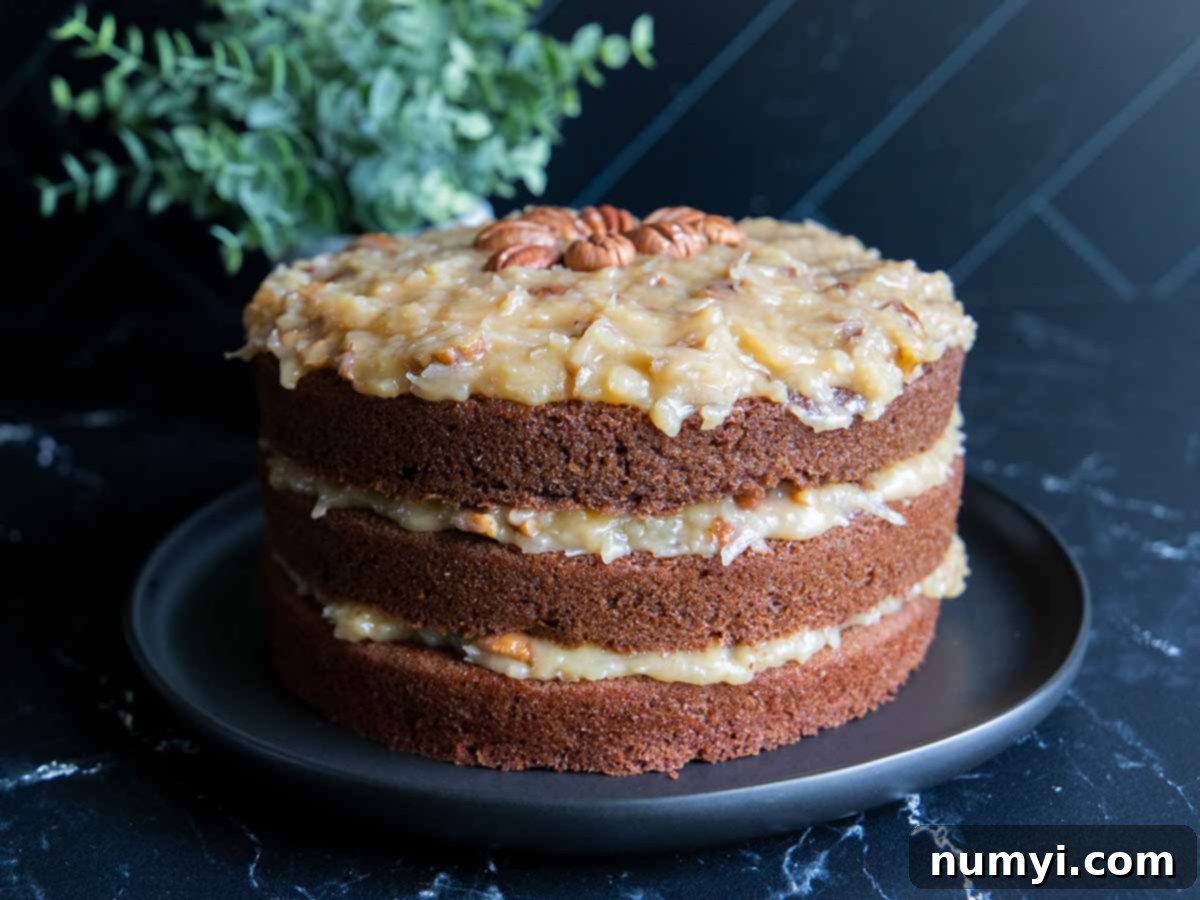The Ultimate Classic Baker’s German Chocolate Cake Recipe with Decadent Coconut Pecan Frosting
Baker’s German Chocolate Cake stands as a true icon in American baking, revered for its uniquely mild chocolate flavor and the unmistakable, rich coconut pecan frosting that crowns each moist layer. Far from being overly sweet, this cake strikes a perfect balance, offering a sophisticated dessert experience that appeals to a wide range of palates. It’s a beloved classic, often gracing holiday tables and birthday celebrations, bringing smiles with every forkful. This recipe guides you through crafting an authentic version of this celebrated dessert, ensuring every component, from the tender chocolate cake to the luscious, nutty topping, is nothing short of perfection. Prepare to delight your senses with a cake that’s both deeply comforting and elegantly impressive.
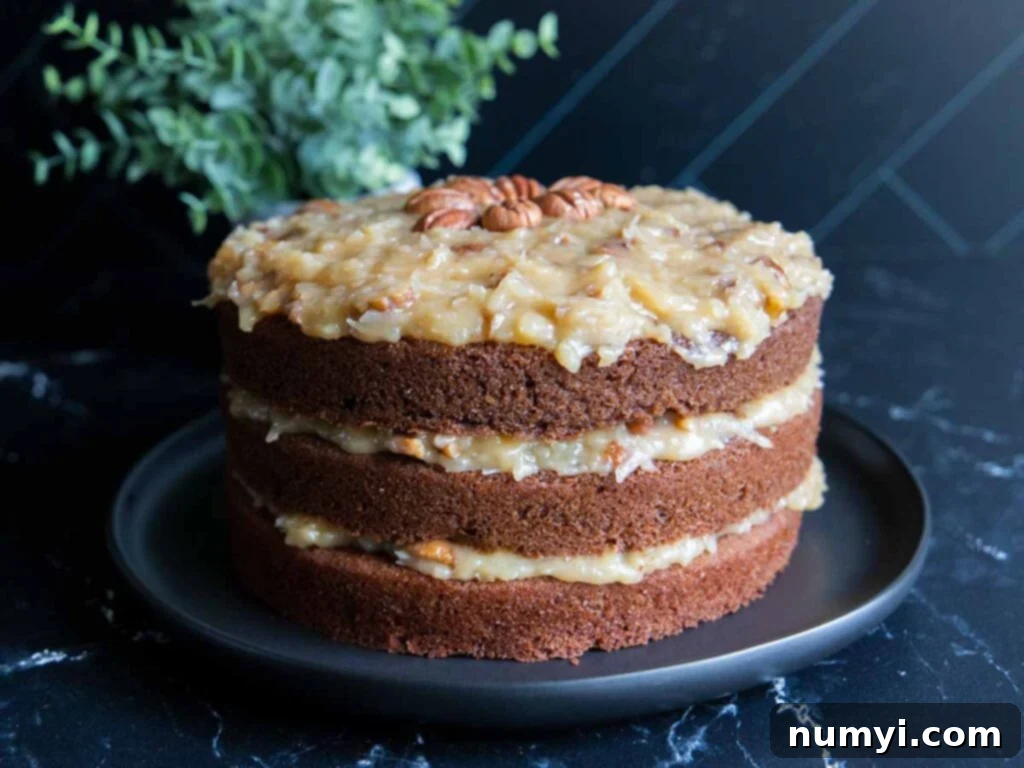
The Fascinating History of German Chocolate Cake
Despite its name, the renowned German Chocolate Cake doesn’t hail from Germany. This classic American dessert actually gets its unique moniker from an American baker named Samuel German. In 1852, Samuel German developed a type of dark baking chocolate for the Baker’s Chocolate Company. To distinguish it from other baking chocolates, the company branded it “Baker’s German’s Sweet Chocolate.” Over a century later, in 1957, a Dallas, Texas homemaker named Mrs. George Clay submitted a recipe for “German’s Chocolate Cake” to a local newspaper. Her recipe, featuring the distinctive sweet baking chocolate, quickly gained national popularity after being picked up by General Foods, which owned Baker’s Chocolate at the time. Thus, what began as “German’s Chocolate Cake” (possessive, referring to Mr. German) eventually became commonly known as “German Chocolate Cake,” leading to a widespread misunderstanding about its origins. The original recipe is a hands-down favorite, and this version keeps true to its delicious legacy.
Why You’ll Adore This Authentic German Chocolate Cake
This particular rendition of the Baker’s German Chocolate Cake is truly special, promising to become a cherished addition to your recipe collection. Here’s why you’ll absolutely love making and sharing it:
- Unforgettable Flavor and Texture: You’ll experience a cake that is wonderfully light and fluffy, boasting a subtly sweet chocolate flavor that pairs perfectly with the star of the show: a rich, creamy, and deeply satisfying coconut pecan frosting. Each bite offers a harmonious blend of tender cake and crunchy, chewy topping.
- A Guaranteed Crowd-Pleaser: This cake isn’t just a dessert; it’s a celebration! Its impressive appearance and universally loved flavors make it ideal for any special occasion, from festive holiday gatherings and joyous birthday parties to casual Sunday dinners. Expect rave reviews and requests for the recipe!
- Surprisingly Simple to Make: Don’t let its gourmet appearance intimidate you. While the results are extraordinary, the process is straightforward and manageable for bakers of all skill levels. We’ve streamlined some steps from the original method without compromising on flavor or texture, making it even more accessible.
- Simplified Baking Process: In our updated approach, we skip the step of beating egg whites to stiff peaks separately. After extensive testing, we found that incorporating whole eggs directly into the batter yields a cake that is just as moist and tender, simplifying the overall process and saving you time without sacrificing quality. This adjustment makes the cake easier to prepare, ensuring a consistent and delicious outcome every time.
If you’re interested in exploring the original recipe method, which involves separating egg whites and folding them in, you can find detailed notes and instructions within the recipe card located at the bottom of this post. For those who adore coconut, be sure to also try our light and fluffy Coconut Cake Recipe and our delightful Coconut Cupcake Recipe for more tropical treats!

Essential Recipe Ingredients for Cake Perfection
Crafting the perfect Baker’s German Chocolate Cake starts with selecting the right ingredients. Each component plays a vital role in achieving the cake’s signature flavor and texture:
- Boiling water – This crucial ingredient isn’t just for hydration; it’s used to gently melt the Baker’s German’s Sweet Baking Chocolate, creating a smooth, rich chocolate base that infuses the cake with its subtle cocoa notes.
- Baker’s German’s Sweet Baking Chocolate (Bakers Sweet German Chocolate) – This specific chocolate is the star ingredient and key to the cake’s authentic flavor. Containing approximately 46% cacao, it provides a distinctive, mildly sweet chocolate flavor, different from typical unsweetened or semi-sweet chocolates, ensuring a wonderfully balanced, never overpowering, chocolate cake.
- All-purpose flour, baking soda, and salt – These dry ingredients form the structural foundation of the cake. The all-purpose flour provides body, while baking soda acts as a leavening agent, reacting with the buttermilk to create a light, tender crumb. Salt balances the sweetness and enhances all the other flavors.
- Unsalted butter – The original recipe thoughtfully calls for either butter or margarine. For the richest flavor and best texture, we recommend using unsalted butter, softened to room temperature. It contributes to the cake’s tender crumb and adds depth of flavor.
- Granulated sugar, vanilla extract – Granulated sugar sweetens the cake and aids in creating a moist texture. Pure vanilla extract is essential for its aromatic qualities, adding a warm, complex flavor that complements the chocolate beautifully.
- Eggs, buttermilk – These wet ingredients should always be at room temperature for optimal baking results. Room temperature eggs emulsify more effectively with butter and sugar, creating a smoother batter. Buttermilk, with its acidic properties, reacts with the baking soda to leaven the cake, resulting in a delightfully light and moist texture. In this simplified recipe, we incorporate the eggs whole, eliminating the need to separate yolks from whites, making the process much easier without sacrificing quality.

Don’t Sweat The Recipe is supported by its readers. We may earn a commission if you purchase through a link on our site. Learn more.
Baking the Perfect Baker’s German Chocolate Cake: A Step-by-Step Guide
Creating this magnificent cake is a rewarding process. Follow these detailed steps to ensure each layer is moist, flavorful, and ready for that incredible frosting:
First, preheat your oven to 350 degrees F (175 C). Properly prepare your cake pans to prevent sticking and ensure easy release. You’ll need three 8-inch round cake pans or two 9-inch round cake pans. Line the bottoms of the pans with parchment paper and grease them thoroughly. This step is crucial for beautifully intact cake layers. Set them aside while you prepare the batter.
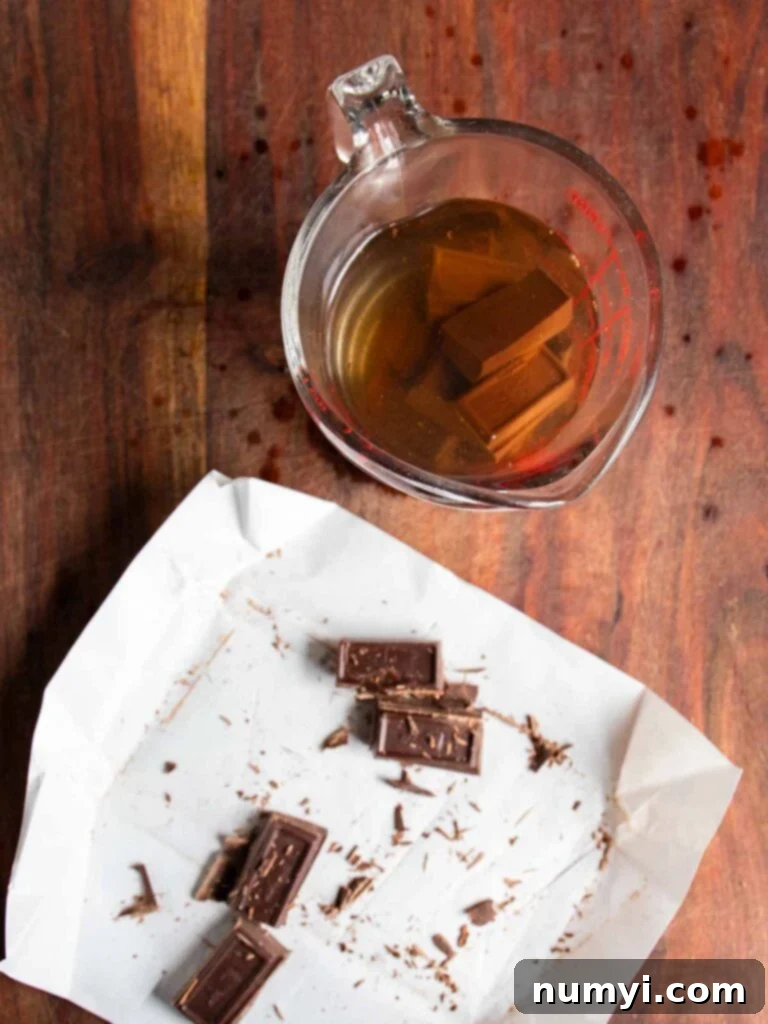
In a heatproof glass measuring cup, carefully microwave the water until it reaches a rolling boil. Add the Baker’s German’s Sweet Baking Chocolate to the hot water. Stir constantly until the chocolate is completely melted and the mixture is smooth and glossy. This chocolate mixture will be mildly warm, perfect for incorporating into your batter. Set it aside to cool slightly.
Next, in a medium-sized bowl, whisk together your dry ingredients: the all-purpose flour, baking soda, and salt. Whisking ensures these ingredients are evenly distributed, which is essential for uniform leavening and flavor throughout the cake. Set this bowl aside for later use.
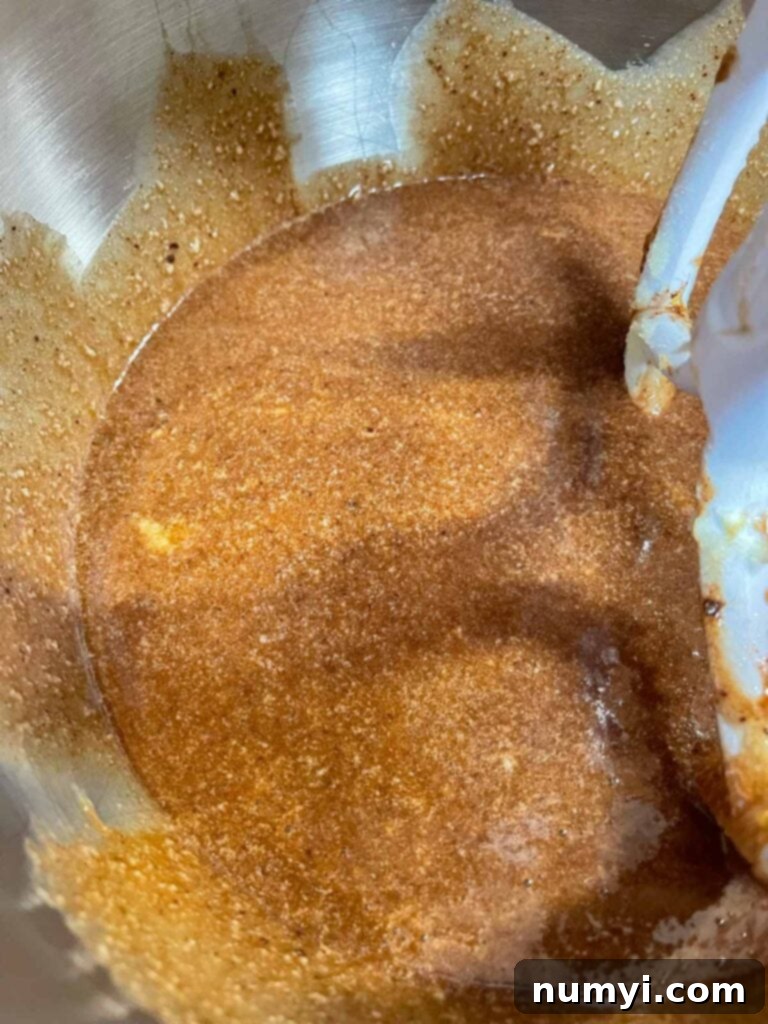
In a large mixing bowl, using an electric mixer, cream together the softened unsalted butter and granulated sugar on medium speed. Beat for approximately 3-4 minutes, or until the mixture becomes light, fluffy, and pale in color. This creaming process incorporates air, which contributes to the cake’s tender texture. Add the room-temperature eggs (whole eggs, no separation required for this simplified recipe), one at a time, beating thoroughly after each addition until fully incorporated. This gradual addition prevents the batter from curdling and ensures a smooth consistency.
Once the eggs are incorporated, gently stir in the cooled melted chocolate mixture and the vanilla extract. Mix until just combined, being careful not to overmix. The batter will start to take on a beautiful chocolate hue.
Now, it’s time to combine the wet and dry ingredients. Add the flour mixture in three additions, alternating with the buttermilk in two additions. Begin and end with the flour mixture. Beat on low speed after each addition until just smooth. Avoid overmixing, as this can develop the gluten in the flour too much, leading to a tough cake. Mix only until no streaks of flour remain.
Evenly divide the prepared cake batter among your three (8-inch) or two (9-inch) cake pans. For precise distribution and even layers, aim for approximately 2 1/2 cups of batter per 8-inch pan. Smooth the tops gently with a spatula.

Bake in the preheated oven for about 30 minutes, or until a wooden skewer or toothpick inserted into the center of the cake comes out clean, and the cake springs back lightly when pressed. Baking times can vary depending on your oven and pan size, so keep a close eye on them.
Once baked, transfer the hot cake pans to a wire rack to cool in the pans for at least 15 minutes. This allows the cakes to set properly and prevents them from breaking when removed. After 15 minutes, carefully invert the cakes onto the wire rack to cool completely. It is absolutely essential that the cake layers are entirely cooled before you attempt to frost them; otherwise, the frosting will melt and slide off.
Crafting the Iconic Coconut Pecan Frosting
The distinctive coconut pecan frosting is arguably what makes German Chocolate Cake so legendary. This decadent, chewy, and nutty topping is relatively simple to prepare, but requires constant attention to achieve its signature rich texture and golden-brown hue.
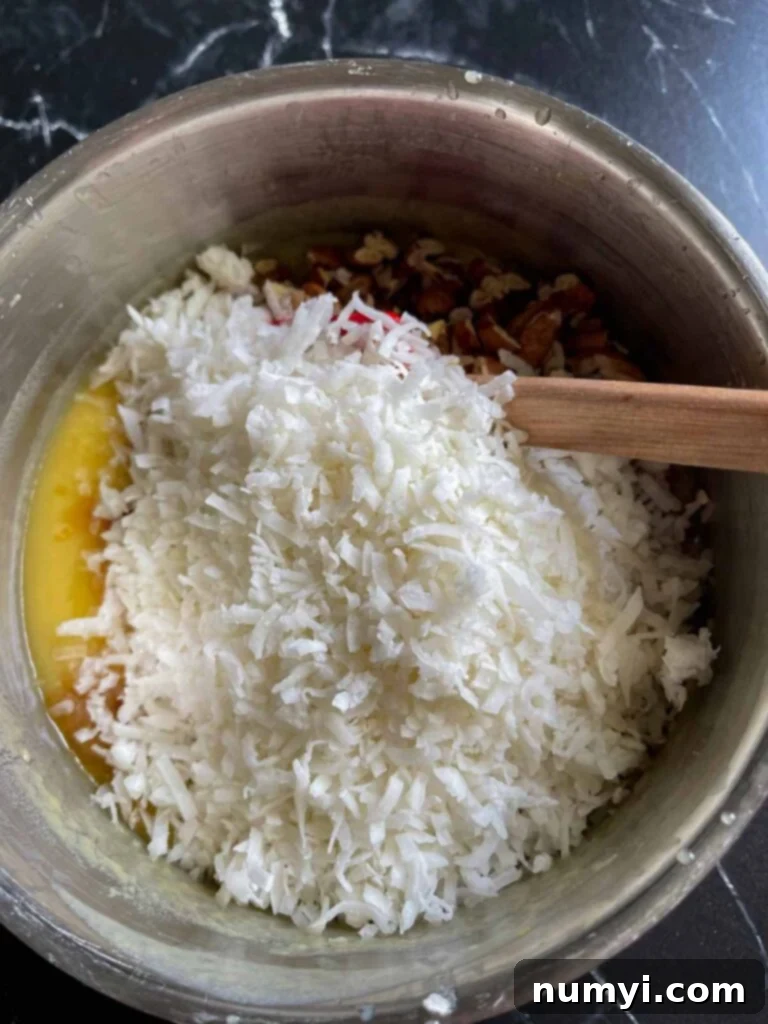
In a large, heavy-bottomed saucepan, combine the evaporated milk, granulated sugar, unsalted butter, egg yolks, and a pinch of salt. Place the saucepan over medium heat. This mixture will need to be cooked carefully to prevent scorching and ensure proper thickening. Begin to cook, stirring constantly with a whisk or wooden spoon, making sure to scrape the bottom and sides of the pan. This constant stirring is vital to prevent the eggs from scrambling and the mixture from sticking. Continue cooking for approximately 12 minutes, or until the frosting has thickened considerably and achieved a beautiful golden-brown color. It should be thick enough to coat the back of a spoon. Do not rush this step; patience will be rewarded with a perfectly cooked frosting.
Once the frosting reaches the desired consistency and color, remove the saucepan from the heat immediately. Stir in the shredded coconut, toasted and chopped pecans, and vanilla extract. The residual heat will help the flavors meld and slightly toast the coconut further. Mix until all ingredients are well combined and evenly distributed throughout the rich, thick base. Transfer the frosting to another bowl and allow it to cool completely to room temperature. As it cools, it will thicken even further, becoming the perfect spreadable consistency for your cake. Stir occasionally as it cools to prevent a skin from forming.
Assembling Your Masterpiece: Layering the German Chocolate Cake
With your perfectly baked and cooled cake layers and decadent coconut pecan frosting ready, it’s time for the grand finale: assembly! This is where your beautiful cake truly comes to life.
Choose a sturdy cake plate or serving platter. Carefully place your first cooled cake layer onto the plate. Using an offset spatula or a knife, spread approximately one-third of the rich coconut pecan frosting evenly over the top of this first layer. Ensure you leave a small 1/4-inch border around the edge of the cake. This border helps contain the filling and creates a neat, professional look once the layers are stacked.
Gently place the second cake layer directly on top of the frosted first layer. Now, spread half of the remaining coconut pecan frosting over this second layer, again leaving that crucial 1/4-inch border. The generous amount of frosting between layers is what gives this cake its signature moistness and intense flavor.
Finally, carefully position the third cake layer on top. With the last portion of frosting, spread it evenly over the top of the third layer. For an authentic “naked cake” style, leave the sides of the cake exposed, showcasing the beautiful chocolate layers peeking through. The coconut pecan frosting is typically only applied to the top and between the layers, making the exposed sides a hallmark of Baker’s German Chocolate Cake. Your magnificent cake is now ready to be admired and enjoyed!
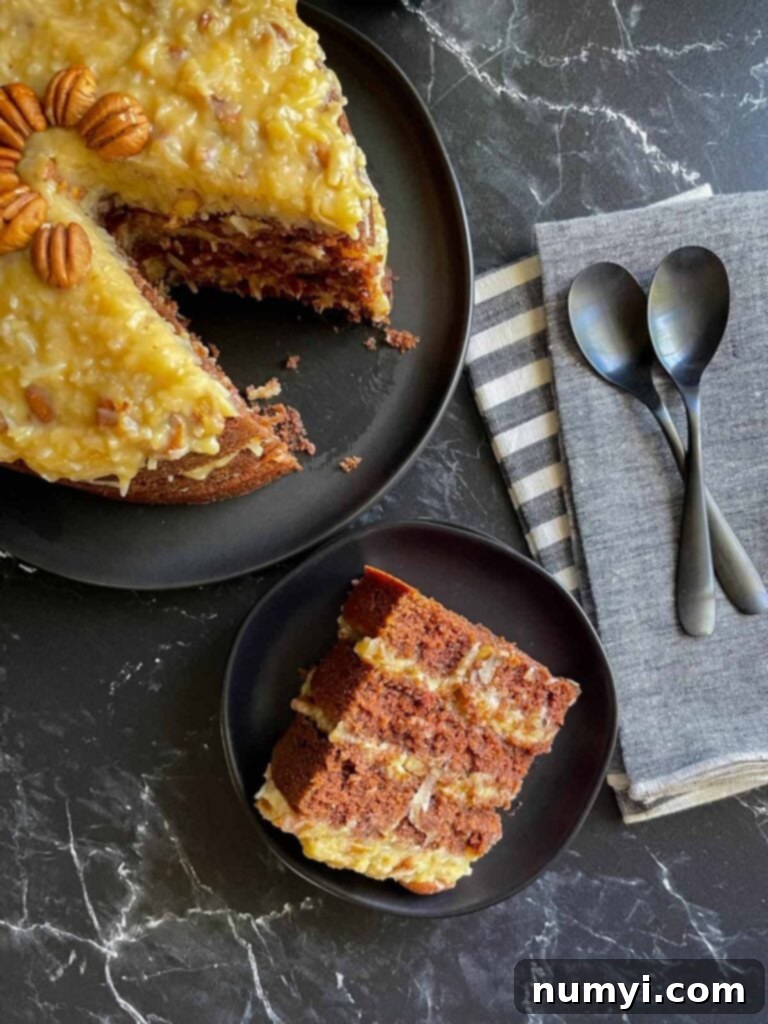
Expert Tips for German Chocolate Cake Success
Achieving a bakery-worthy German Chocolate Cake is simple with these helpful tips:
- Accurate Flour Measurement is Key: For a consistently light and tender cake, proper flour measurement is critical. Never scoop flour directly from the bag. Instead, aerate the flour by whisking it first, then gently spoon it into your measuring cup, and level it off with the back of a knife. This prevents overpacking, which can result in a dense, dry cake.
- Embrace Room Temperature Ingredients: Ensure your eggs and buttermilk are at room temperature before you begin baking. Room temperature ingredients emulsify more smoothly with the fats (like butter), creating a homogeneous batter. This results in a finer crumb and a more evenly textured cake.
- DIY Buttermilk Shortcut: If you find yourself without buttermilk, don’t fret! You can easily make your own. Add 1 tablespoon of white vinegar or lemon juice to a 1-cup liquid measuring cup, then fill the rest with regular milk (any fat percentage works). Let it sit for 5-10 minutes until it slightly curdles. This homemade version works perfectly as a substitute.
- Sourcing Baker’s German Chocolate: Baker’s German’s Sweet Baking Chocolate bars are usually found in the baking aisle of most well-stocked grocery stores. If it’s unavailable, you can create a suitable substitute: use semi-sweet chocolate and add 1 1/2 teaspoons of granulated sugar for every ounce of chocolate to match the sweetness level.
- Handle Hot Chocolate Carefully: When pouring boiling water over the Baker’s chocolate, do so with caution. The mixture might bubble up briefly due to the heat, so ensure you have a stable surface and stir gently.
- Achieve Flat Cake Layers: For beautifully even cake layers, consider using cake strips. These damp fabric strips wrap around the outside of your cake pans, insulating the edges and allowing the cake to bake more evenly, preventing doming. If you don’t use them, you may need to level the tops of your cooled cakes with a serrated knife for perfectly flat layers.
- Softening Thick Frosting: If your coconut pecan frosting becomes too thick to spread easily after cooling, don’t worry. You can gently microwave it for very short intervals (5-10 seconds at a time), stirring between each, until it reaches a more spreadable consistency. Be careful not to overheat it.
- Toasting Pecans: Toasting your pecans before adding them to the frosting will significantly enhance their flavor. Spread them on a baking sheet and toast in a 350°F (175°C) oven for 5-7 minutes, or until fragrant. Let them cool before chopping.
Frequently Asked Questions About German Chocolate Cake
Absolutely! German Chocolate Cake is an excellent make-ahead dessert. You can bake the cake layers up to two days in advance. Once they’re completely cooled, wrap each layer tightly in plastic wrap and store them in the refrigerator. For longer storage, the layers can be frozen for up to 3 months when wrapped properly. When you’re ready to assemble, defrost the frozen layers to room temperature, then prepare the coconut pecan frosting and proceed with assembly as directed. This flexibility makes it perfect for entertaining.
If you can’t find Baker’s German’s Sweet Baking Chocolate, a good substitute can be made using semi-sweet chocolate. For every ounce of Baker’s German chocolate called for in the recipe, use an ounce of semi-sweet chocolate and add 1 1/2 teaspoons of granulated sugar. This will help approximate the sweetness and cacao percentage of the original. Make sure to melt it with boiling water as per the recipe instructions.
To maintain its freshness and flavor, store this cake in an airtight container. At room temperature, it will stay fresh for up to 3 days. If you need to store it longer, it can be refrigerated for up to 7 days. It’s important to note that the coconut pecan frosting will firm up when cold, so for the best taste and texture, allow the cake to come to room temperature for at least 30-60 minutes before serving.
Yes, freezing individual slices is a fantastic way to enjoy your cake over a longer period. I recommend cutting the cake into individual slices, then placing them on a baking sheet lined with parchment paper. Freeze them for about 1 hour, or until they are firm. Once frozen solid, wrap each slice tightly in plastic wrap, then place them in a freezer-safe container or a resealable freezer bag. Frozen slices can be stored for up to 2 months for optimal quality. Thaw at room temperature before indulging.
Explore More Decadent Dessert Recipes
If you loved crafting this classic German Chocolate Cake, you’re in for a treat! Our collection of dessert recipes is designed to satisfy every sweet craving. From rich chocolate delights to light and fruity confections, you’ll find plenty more to bake and share. Discover new favorites and revisit timeless classics with our easy-to-follow guides.
Carrot Cake Cheesecake
Dark Chocolate Espresso Cake
Best Homemade Carrot Cake
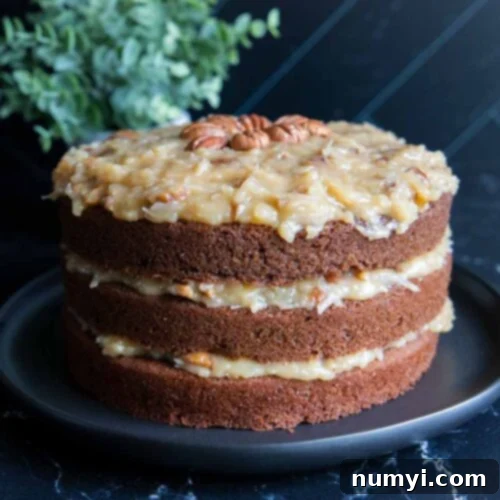
Original Baker’s German Chocolate Cake Recipe
Print
Pin
Rate
Ingredients
For the Cake
- 1/2 cup Water boiling
- 4 oz Baker’s German’s Sweet Baking chocolate 1 package
- 2 cups All-purpose flour
- 1 tsp Baking soda
- 1/2 tsp Salt
- 1 cup Unsalted butter softened
- 2 cups Granulated sugar
- 4 large Eggs room temperature, not separated
- 1 tsp Vanilla extract
- 1 cup Buttermilk room temperature
Coconut Pecan Frosting/Filling
- 12 oz Evaporated milk (1 can)
- 1 1/2 cups Granulated sugar
- 3/4 cup Unsalted butter (1 1/2 sticks)
- 4 large Egg yolks
- 2 tsp Vanilla extract
- 1/8 tsp salt
- 2 1/2 cups Coconut flakes sweetened
- 1 1/2 cups Pecans toasted and chopped
Instructions
For the Cake
-
Preheat the oven to 350 degrees F. Line with parchment paper and grease 3 (8-inch) round cake pans or 2 (9-inch). Set aside.
-
In a glass measuring cup microwave the water until boiling. Stir in the chocolate until completely melted and smooth. Set aside.
-
In a medium-size bowl whisk together the flour, baking soda, and salt. Set aside.
-
In a large mixing bowl beat the butter and sugar together with an electric mixer on medium speed until light and fluffy. About 3-4 minutes. Add the eggs (whole eggs, not separated), one at a time, beating well after each addition.
-
Stir in the melted chocolate mixture and vanilla extract.
-
Beat in the flour mixture in thirds alternating with the buttermilk, beating after each addition until smooth.
-
Divide the cake batter evenly into all three prepared cake pans—about 2 1/2 cups of batter for each pan.
-
Bake for 30 minutes or until cake springs back when lightly pressed in the center. Transfer the cakes to a wire rack to cool for at least 15 minutes in the pan. Remove the cakes from the pan back to the wire rack to cool completely before frosting.
Coconut-Pecan Filling/Frosting
-
In a large saucepan over medium heat add the evaporated milk, sugar, butter, egg yolks, and salt. Cook stirring constantly for 12 minutes, until thickened and golden brown.
-
Remove from the heat and stir in the coconut, pecans, and vanilla. Cool to room temperature.
-
Place one cake layer on a cake plate. Spread one-third of the filling over the top of the cake, leaving a 1/4-inch border. Top with the second layer, spread with half of the remaining filling. Place the third layer on top and spread the remaining frosting evenly over the top, leaving the sides of the cake exposed.
Notes
Storing – Store this cake in an air-tight container at room temperature for up to 3 days or in the refrigerator for up to 7 days. Bring to room temperature before serving, the icing turns firm when cold.
Freezing – I recommend cutting slices, place on a baking sheet lined with parchment paper, and freezing them for about 1 hour or until hard. Wrap the frozen slices tightly in plastic wrap, place them in a freezer-safe container or resealable bag, and freeze for up to 2 months for best quality.
